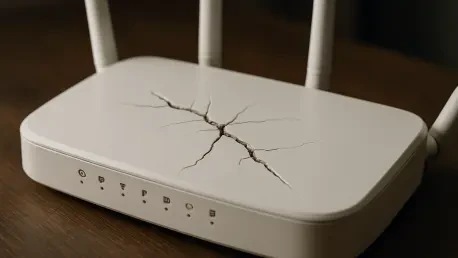In an era where cybersecurity threats loom larger than ever, a newly discovered vulnerability in DrayOS-powered enterprise routers has sent shockwaves through the tech community, raising serious concerns about the security of corporate networks worldwide. Manufactured by DrayTek, these routers are widely used in business environments, making the flaw—a critical memory corruption issue—particularly alarming. This vulnerability allows unauthenticated remote attackers to exploit the system, potentially crashing devices or executing arbitrary code with root privileges. Discovered through responsible disclosure by a cybersecurity expert from ChapsVision, the issue underscores the fragility of network infrastructure when proper safeguards are not in place. As cyber threats continue to evolve, understanding the scope of this flaw and the steps needed to mitigate it becomes paramount for organizations relying on these devices to maintain secure and uninterrupted operations.
Understanding the Vulnerability
Mechanics of the Exploit
At the heart of this critical issue lies a flaw in the Web User Interface (WebUI) of DrayTek routers running DrayOS, where inadequate validation of input from HTTP(S) requests creates a dangerous opening for attackers. This oversight in handling user input leads to memory corruption, a condition that can cause system instability or, worse, allow the execution of malicious code. What makes this vulnerability especially perilous is the lack of authentication requirements, meaning that attackers do not need credentials to exploit it. Proof-of-concept exploits have demonstrated how crafted requests can trigger crashes or enable shell command execution with root-level access on unpatched firmware. The ease of exploitation amplifies the risk, as attackers can target vulnerable devices with minimal effort, potentially compromising entire networks and accessing sensitive data stored or transmitted through these routers.
Scope of Exposure Across Networks
The exposure created by this flaw varies depending on network configurations, but the potential for widespread impact remains high. If remote access to the WebUI or SSL VPN is enabled on the Wide Area Network (WAN) interface, attackers can exploit the vulnerability from anywhere on the internet, making external threats a significant concern. On the Local Area Network (LAN) side, risks emerge when an attacker gains internal access, perhaps through phishing or other means, and targets the WebUI directly. Different DrayTek models, including Vigor1000B, Vigor2962, and Vigor3910, among others, are affected, showcasing the broad reach of this issue across enterprise environments. The diversity of vulnerable devices highlights the urgent need for administrators to assess their specific setups and understand whether their network’s configuration heightens the likelihood of an attack through either remote or local exploitation vectors.
Mitigation and Protective Measures
Immediate Actions for Firmware Updates
Addressing this severe vulnerability starts with applying firmware updates released by DrayTek for all affected models, a step that cannot be delayed given the critical nature of the flaw. Specific minimum firmware versions have been designated to eliminate the risk, and administrators must ensure these patches are deployed across their networks without exception. For instance, models like Vigor2962 and Vigor3910 have tailored updates that address the memory corruption issue at its core. Beyond simply installing updates, organizations should establish a routine for monitoring security advisories to stay ahead of future vulnerabilities. This proactive approach to patch management serves as the first line of defense, significantly reducing the window of opportunity for attackers to exploit unpatched systems and ensuring that network devices remain resilient against known threats targeting DrayOS routers.
Advanced Security Configurations
Beyond firmware updates, implementing robust security configurations is essential to safeguard against this vulnerability and similar threats. Disabling remote WebUI and SSL VPN access on WAN interfaces is a critical recommendation, as it prevents external attackers from reaching the vulnerable components. Additionally, enforcing Access Control Lists (ACLs) to restrict WebUI access to trusted hosts and implementing VLAN segmentation on LAN interfaces can isolate management functions, reducing internal risks. For organizations that require remote management, adopting out-of-band solutions like dedicated management networks or zero-trust tools offers a safer alternative. Regular penetration testing and log analysis for suspicious WebUI activity further enhance security by identifying potential breaches early. These layered defenses, when combined with timely updates, create a comprehensive shield against exploitation, ensuring that corporate networks are not left exposed to remote code execution risks.
Long-Term Strategies for Network Defense
Looking beyond immediate fixes, organizations must adopt long-term strategies to fortify their network infrastructure against evolving cyber threats. Conducting routine patch audits ensures that no device remains vulnerable due to oversight, while continuous monitoring of security advisories keeps administrators informed of emerging risks. Building a culture of cybersecurity awareness within the organization can also mitigate internal threats, such as those arising from social engineering tactics that grant attackers LAN access. Investing in advanced threat detection systems and regularly updating security protocols based on industry best practices adds another layer of protection. The responsible disclosure of this flaw by a cybersecurity expert serves as a reminder of the value of collaboration in identifying and addressing vulnerabilities, encouraging organizations to engage with the broader security community to stay ahead of potential dangers.
Reflecting on the Path Forward
Lessons Learned from a Severe Threat
Reflecting on the aftermath of this alarming vulnerability in DrayOS routers, it becomes evident that the cybersecurity landscape demands constant vigilance from all stakeholders involved. The memory corruption flaw, which allowed unauthenticated remote attackers to potentially seize control of enterprise networks, exposed a critical weakness that had lingered in widely used DrayTek devices. The swift response from the manufacturer in releasing firmware updates for models like Vigor1000B and Vigor3910, coupled with detailed guidance on secure configurations, played a pivotal role in curbing the immediate danger. This incident also highlighted how the absence of proper input validation had nearly catastrophic consequences, serving as a stark reminder of the importance of rigorous software testing and security standards in the development of network hardware.
Building a Resilient Future
As the dust settles on this critical issue, the focus shifts toward actionable steps to prevent similar vulnerabilities from emerging in the future. Organizations are encouraged to prioritize the integration of zero-trust architectures and out-of-band management solutions to minimize exposure of critical systems. Establishing partnerships with cybersecurity experts and participating in threat intelligence sharing becomes vital for staying informed about new risks. Additionally, investing in automated patch management tools emerges as a practical solution to ensure timely updates across sprawling networks. By adopting these forward-thinking measures and maintaining strict access controls, businesses can better safeguard their infrastructure, turning the lessons from this severe flaw into a foundation for stronger, more resilient network security in the years ahead.









